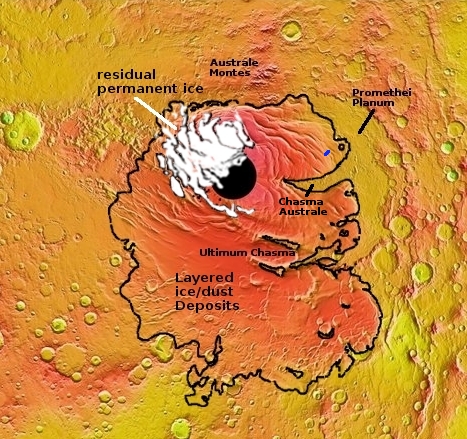A Martian starburst spider
Cool image time! The photo to the right, cropped to post here, illustrates an example of a wholly unique Martian phenomenon, that is not only unique to Mars but is also found only in its south polar regions. The image was taken on July 17, 2020 by the high resolution camera on Mars Reconnaissance Orbiter (MRO).
What we are looking at is a permanent spider formation etched into the layered deposits of ice and dirt that cover the widest area surrounding Mars’ south pole. The blue dot just north of Chasma Australe on the overview map below shows the location of these starbursts, on those layered deposits.
Each winter the poles of Mars are blanketed with a thin mantle of dry ice, generally less than six feet thick. When spring arrives and sunlight hits this mantle, it heats the ice and sand on which the mantle lies, and that warmth causes the mantle’s base to sublimate back into gas. Eventually gas pressure causes the mantle to crack at its weak points so the gas can escape. By the time summer arrives that mantle is entirely gone, all of it returning to the atmosphere as CO2 gas.
This sublimation process differs between the north and south pole, due to the different terrain found at each. In the north the mantle mostly lies on ice or sand dunes, neither of which is stable over repeated years. Thus, the mantle weak points do not occur at the exact same place each year, even though they occur at the same type of locations, such as the base and crests of dunes.

In the south however the ground is more stable, so that each year the trapped gas at the base of the mantle travels upward along the same exact paths, repeatedly etching into that ground the meandering spider patterns we see in the image above.
Think of these lines as river tributaries, except that the flow here is gas and it is upward to the surface, not downward following gravity. Moreover, in the case of these starbursts, the flow is going uphill on all sides of a small peak, until the separate flows meet at the top, where they escape.
Essentially the starbursts are vaguely reflecting the surface topography of the layered ice/dust deposit on which they sit. At this spot there several high points, and surrounding each is a starburst.
I’ve said it before, but it bears repeating: Mars is strange. Mars is alien. Mars epitomizes the universe in all its glory.
On Christmas Eve 1968 three Americans became the first humans to visit another world. What they did to celebrate was unexpected and profound, and will be remembered throughout all human history. Genesis: the Story of Apollo 8, Robert Zimmerman's classic history of humanity's first journey to another world, tells that story, and it is now available as both an ebook and an audiobook, both with a foreword by Valerie Anders and a new introduction by Robert Zimmerman.
The print edition can be purchased at Amazon or from any other book seller. If you want an autographed copy the price is $60 for the hardback and $45 for the paperback, plus $8 shipping for each. Go here for purchasing details. The ebook is available everywhere for $5.99 (before discount) at amazon, or direct from my ebook publisher, ebookit. If you buy it from ebookit you don't support the big tech companies and the author gets a bigger cut much sooner.
The audiobook is also available at all these vendors, and is also free with a 30-day trial membership to Audible.
"Not simply about one mission, [Genesis] is also the history of America's quest for the moon... Zimmerman has done a masterful job of tying disparate events together into a solid account of one of America's greatest human triumphs."--San Antonio Express-News
Cool image time! The photo to the right, cropped to post here, illustrates an example of a wholly unique Martian phenomenon, that is not only unique to Mars but is also found only in its south polar regions. The image was taken on July 17, 2020 by the high resolution camera on Mars Reconnaissance Orbiter (MRO).
What we are looking at is a permanent spider formation etched into the layered deposits of ice and dirt that cover the widest area surrounding Mars’ south pole. The blue dot just north of Chasma Australe on the overview map below shows the location of these starbursts, on those layered deposits.
Each winter the poles of Mars are blanketed with a thin mantle of dry ice, generally less than six feet thick. When spring arrives and sunlight hits this mantle, it heats the ice and sand on which the mantle lies, and that warmth causes the mantle’s base to sublimate back into gas. Eventually gas pressure causes the mantle to crack at its weak points so the gas can escape. By the time summer arrives that mantle is entirely gone, all of it returning to the atmosphere as CO2 gas.
This sublimation process differs between the north and south pole, due to the different terrain found at each. In the north the mantle mostly lies on ice or sand dunes, neither of which is stable over repeated years. Thus, the mantle weak points do not occur at the exact same place each year, even though they occur at the same type of locations, such as the base and crests of dunes.

In the south however the ground is more stable, so that each year the trapped gas at the base of the mantle travels upward along the same exact paths, repeatedly etching into that ground the meandering spider patterns we see in the image above.
Think of these lines as river tributaries, except that the flow here is gas and it is upward to the surface, not downward following gravity. Moreover, in the case of these starbursts, the flow is going uphill on all sides of a small peak, until the separate flows meet at the top, where they escape.
Essentially the starbursts are vaguely reflecting the surface topography of the layered ice/dust deposit on which they sit. At this spot there several high points, and surrounding each is a starburst.
I’ve said it before, but it bears repeating: Mars is strange. Mars is alien. Mars epitomizes the universe in all its glory.
On Christmas Eve 1968 three Americans became the first humans to visit another world. What they did to celebrate was unexpected and profound, and will be remembered throughout all human history. Genesis: the Story of Apollo 8, Robert Zimmerman's classic history of humanity's first journey to another world, tells that story, and it is now available as both an ebook and an audiobook, both with a foreword by Valerie Anders and a new introduction by Robert Zimmerman.
The print edition can be purchased at Amazon or from any other book seller. If you want an autographed copy the price is $60 for the hardback and $45 for the paperback, plus $8 shipping for each. Go here for purchasing details. The ebook is available everywhere for $5.99 (before discount) at amazon, or direct from my ebook publisher, ebookit. If you buy it from ebookit you don't support the big tech companies and the author gets a bigger cut much sooner.
The audiobook is also available at all these vendors, and is also free with a 30-day trial membership to Audible.
"Not simply about one mission, [Genesis] is also the history of America's quest for the moon... Zimmerman has done a masterful job of tying disparate events together into a solid account of one of America's greatest human triumphs."--San Antonio Express-News



Mars has “continental sized” dust storms yearly, and a global one on average about every 6 years. Doesn’t the movement of dust change the landscape as imaged from orbit, as permanent features are covered and uncovered?
LocalFluff: The answer is yes, but only to a somewhat limited extent. The atmosphere is just not thick enough and thus cannot blow hard enough to physically change much.
See these posts for some examples however:
You will notice that most of the changes are somewhat superficial. The winds didn’t change things much besides the appearance of the ground’s top surface.
I must add that we are talking about the short term seasonal changes. Over a very long time (thousands of years) the winds can erode a lot, just as they do on Earth. It just takes longer.
In the larger scale image of the Ice cap region, I presume the zone marked “layered ice/dust” is just water ice? Or is there dry ice mixed in there too?
Brad: Click on the link under the words “south pole.” I go into some detail about the south pole. The layered deposits are exactly what I wrote, layered deposits of ice and dust mixed together. It is part of the permanent cap, but unlike the north pole, it is not covered by the purer residual permanent icecap. In the south the residual permanent ice cap covers only a small portion.
Brad: I just realized I did not answer your question. There is no dry ice in the layered deposits. The only time we see dry ice at the poles is in the winter when the CO2 in the atmosphere falls as dry ice snow to create the seasonal mantle on top of the ice.
And the Red Planet Mars Red Dust Storms that would mean Winds could mars have Winds?
Angry Red Planet of spiders